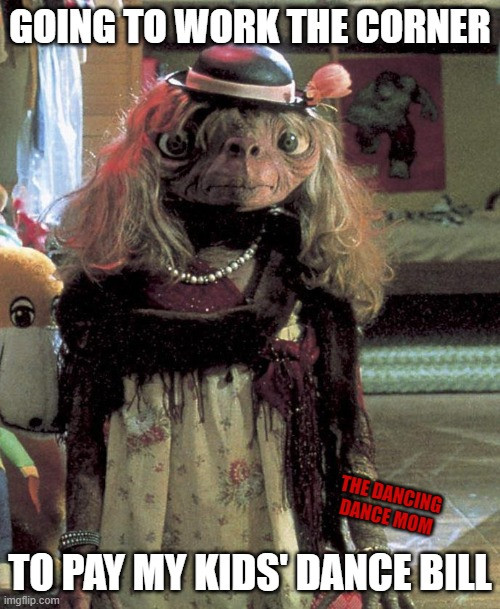My kids want solos, so I’m willing to do whatever it takes (even if it costs me whatever dignity I have left). This sentiment resonates deeply with any parent involved in competitive dance. We envision the sparkle of the stage, the elegance of movement, and yes, the beauty of the dance dress. But behind the glamour lies a financial commitment that often takes center stage.
Years ago, my experience with a Pop Warner dance team painted a different financial picture. Participation was remarkably affordable, around $100 a year. The registration fees were minimal, and uniform costs were covered by the organization, with outfits passed down through the years. Fundraising was key to covering larger expenses like trips to Nationals, but even then, costs were managed through community efforts and reasonable spectator ticket sales. As a non-profit, the focus was on accessibility, ensuring that financial constraints wouldn’t exclude any child from the joy of dance.
 A woman in an elaborate, sequined costume, representing the high costs associated with competitive dance dresses and attire
A woman in an elaborate, sequined costume, representing the high costs associated with competitive dance dresses and attire
Sticker Shock: Unveiling the True Price Tag of Competitive Dance
Entering the world of competitive dance was a financial awakening. While I anticipated higher costs, the sheer scale was staggering. Even when my daughters were involved in just one competitive routine, the expenses were noticeable. Had my ex-husband remained in the picture, the escalating costs of costumes alone, let alone additional routines and solos, might have caused serious alarm. For anyone familiar with competitive dance, this comes as no surprise. Dance moms everywhere understand the significant budget required to support our children’s passion. It’s a financial reality that extends beyond dance, as highlighted in reports like NBC’s “The Costs of Competitive Kids,” indicating that specialized activities for children often come with substantial price tags.
The Financial Reality: Dance Budgets and Sacrifices
The financial commitment to dance became starkly clear during my divorce. The explicit threat of halting negotiations if I pursued financial contribution for dance education underscored the immense personal responsibility I was taking on. Navigating divorce often involves difficult compromises, and in my case, ensuring my daughters could continue dancing meant shouldering the full financial burden.
This decision profoundly impacted our family’s financial planning. When purchasing a new home, the monthly dance expenses became a crucial factor in determining our mortgage budget. Birthday and holiday gifts for the girls are often channeled directly into their “dance fund,” a pragmatic choice that sometimes brings a pang of regret. Extravagant vacations became a thing of the past, replaced with local beach outings and budget-friendly day trips. These are the everyday sacrifices many families make to keep dance alive in their children’s lives.
Making it Work: Balancing Passion and Practicality
The sacrifices are numerous and often misunderstood. From external skepticism to internal financial juggling, the path of a dance parent is rarely straightforward. Explaining the profound importance of dance to my daughters is often met with blank stares from those outside our dance community.
Constantly seeking ways to supplement income to meet the rising costs of competitive dance is a common thread among dance moms. While extreme measures are out of the question, the creativity and resourcefulness of dance parents in finding extra funds are constantly tested.
Work hard, have fun! – Danielle
Beyond the Dance Dress: Understanding All the Costs
The allure of a beautiful dance dress is undeniable. The sequins, the fabrics, the custom designs – they are a visual representation of the artistry of dance. However, the expense of a dance dress is just one facet of the overall financial picture. Consider the layers of costs that contribute to a dancer’s journey:
- Tuition Fees: Regular dance classes form the foundation, and these fees accumulate over months and years.
- Costume Expenses: Beyond the stunning dance dress, each routine often requires unique costumes, and solo or duo performances can significantly increase these costs.
- Competition Entry Fees: Each competition event incurs entry fees, and participating in multiple events throughout the season adds up quickly.
- Travel and Accommodation: Regional and national competitions often necessitate travel, hotel stays, and meals away from home.
- Shoes and Accessories: Specialized dance shoes, tights, hair accessories, and makeup are essential and recurring expenses.
- Private Lessons: Many competitive dancers invest in private lessons to refine their technique and choreography, adding another layer of cost.
When you consider all these elements, the investment in competitive dance becomes substantial. While the dance dress might be the most visually striking expense, it’s crucial to understand the full scope of financial commitment required to support a dancer’s passion. It’s about budgeting, making choices, and finding a balance between dreams and financial realities. For many dance families, it’s a labor of love, a commitment to nurturing their child’s talent and dedication, even when it requires significant financial and personal sacrifices.

